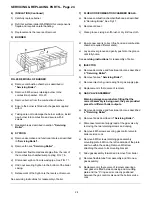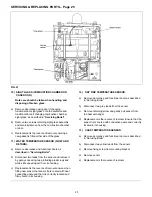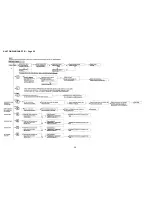
32
APPENDIX A – Page 32
Burner pressure checking and adjustment procedure.
This appliance is fitted with a Gas/Air ratio control mixing
valve. This gas valve ensures that the correct amount of
gas is delivered to the burner to match the available air
supply under all operating conditions. The burner pressure
and gas rate have been precisely set and checked during
manufacture and it is extremely unlikely that any further
adjustment will be necessary.
To check the correct operation of the gas valve follow the
instructions below carefully.
a.
A good indication of correct operation of the boiler will
be obtained by measuring the gas rate at the gas
meter.
1.
Run the appliance for at least 10 minutes.
2.
With all other gas appliances turned off measure
the gas rate at the meter for a period of at least 5
minutes. Check that the measured rate is within ±
5% of the rate stated on the data plate.
b.
To measure the burner pressure.
1.
Turn off the gas service cock. Fit a pressure
gauge to the gas inlet pressure tapping on the gas
control valve. Connect a differential pressure
gauge or “U” tube manometer between the burner
pressure tapping (high pressure side) and the
reference pressure tapping (low pressure side) on
the gas valve (See FIG. 24).
2.
Turn on the gas service cock and run the
appliance for at least 10 minutes. Check that the
gas inlet pressure is between 19-20 mbar.
3.
Check that the differential burner pressure is
within ± 0.5 mbar of that stated on the data plate.
4.
Turn off the gas service cock and remove the
pressure gauge and replace the pressure tapping
sealing screws on the gas valve.
A burner pressure reading outside the specified range
does not necessarily indicate a wrongly adjusted gas
valve. Other factors i.e. insufficient air flow will cause the
gas valve to automatically adjust the burner pressure to
maintain safe combustion. Before attempting to adjust the
gas valve a check must be conducted on the whole
appliance to ensure that any other faults present are found
and rectified.
SETTING THE BURNER PRESSURE
WARNING
Setting the burner pressure requires the following
equipment.
ESSENTIAL
1.
A differential pressure gauge or “U” tube manometer
capable of measuring pressures in the range 0-25
mbar (0-10 “H
2
O) with a resolution of 0.1 mbar (0.05
“H
2
O).
2.
A differential pressure gauge capable of measuring
pressures in the range of 0-2.50 mbar (0-1.00 “H
2
O)
with a resolution of 0.01 mbar (0.005 “H2O).
3.
Sufficient flexible tube and “T” piece connector to
enable these instruments to be connected to the gas
valve in the arrangement shown in FIG. 24.
ADVISABLE
A CO
2
analyser capable of measuring CO
2
concentrations
in the range 0-15% with a resolution of 0.1%.
1.
Remove sealing screws and connect the two
differential pressure gauges to the gas valve as
shown in Fig. 24 and remove the adjustment screw
sealing cap.
2.
Run the appliance for at least 10 minutes.
3.
Note the gas valve signal pressure (differential
pressure gauge 2) set the burner pressure (differential
pressure gauge 1) to the corresponding value shown
in Fig. 25 for the appropriate boiler. Screw the
adjuster in to decrease pressure and out to increase
pressure.
4.
If a CO
2
analyser is available check that the flue gas
CO
2
concentration is in line with the value given in the
FIG.25.
If a new burner or fan has been fitted it may be necessary
to adjust the fan speed offset to achieve the correct gas
valve signal pressure. This is accessible by carrying out
the following procedure.
Press the reset button and hold in for 10 secs. At this time
a number between 0 & 6 will be displayed. It is possible to
adjust the fan speed within this range by setting the boiler
control switch to L and return it to the mid position to lower
the speed and switch to H to increase the speed. Press
the reset button once to return to normal operation.
Summary of Contents for envoy 30
Page 4: ...4 TECHNICAL DATA PAGE 4 FIG 2 GENERAL ARRANGEMENT ...
Page 28: ...28 FAULT FINDING CHART 1 Page 28 ...
Page 29: ...29 FAULT FINDING CHART 2 Page 29 ...
Page 30: ...30 BOILER INTERNAL WIRING Page 30 ...
Page 31: ...31 BOILER WIRING LAYOUT Page 31 ...
Page 36: ...36 Back Page ...





































